Page 87 of 426
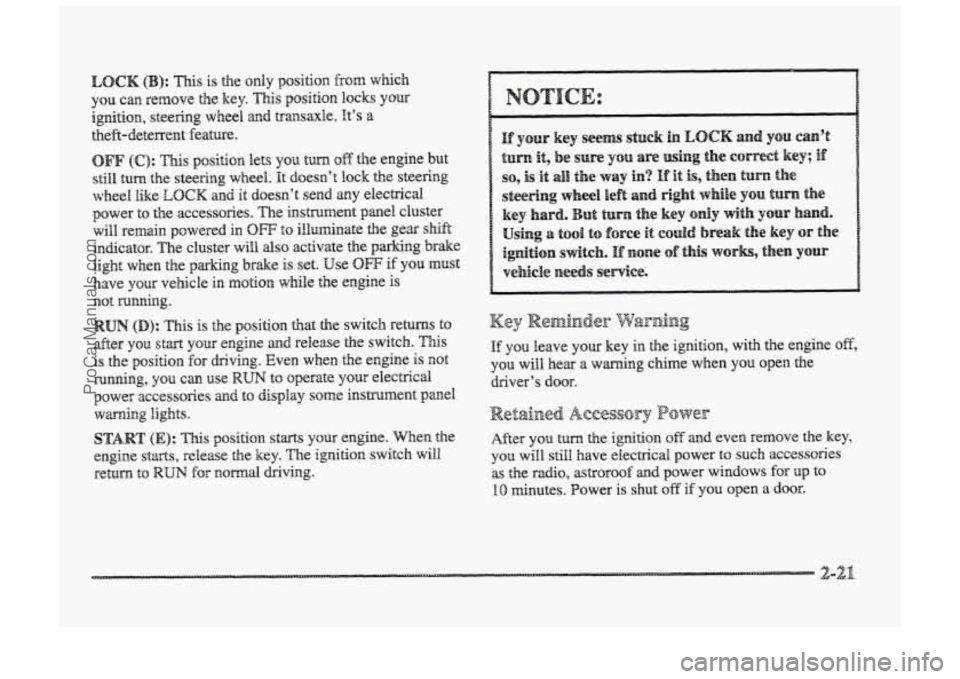
I
LOCK @I: This is the only position from which
YOU can remove the key. This position locks YOU
igition, steering wheel and transaxle. It’s a
theft-deterrent feature.
OFF (C): This position lets YOU turn ofif the engine but
still turn the steering wheel. It doesn’t lock the steering
wrlhee1 like LOCK and it doesn’t send my electrical
power to
the accessories. The instrument panel cluster
will remain powered in OFF to illarminate the gear sWt
indicator. The cluster will also activate the parking brake
fight when the parking brake is set. Use OW if you must
have your vehicle in motion while the engine is
not mnanaing.
RUN (D): This is the position that the switch returns to
after you start YSUP engine and release the switch. This
is &e p~sisi~n for driving. Even when the engine is not
running, you can use RUN to operate your electrical
power accessories anad t~ display some instrument panel
START (E): This position starts your engine. When the
engine
starts, release the key. The ignition switch will
return to RUN for ~a~rrrnal driving.
wdng
lights.
Retained Acces§ory Power
After you turn the ignition off md even remove the key,
you
will still have electrical power to such accessories
as the radio, astroroof ad power windows for up to
10 minutes. Power is shut off if you open a door.
2-21
ProCarManuals.com
Page 88 of 426
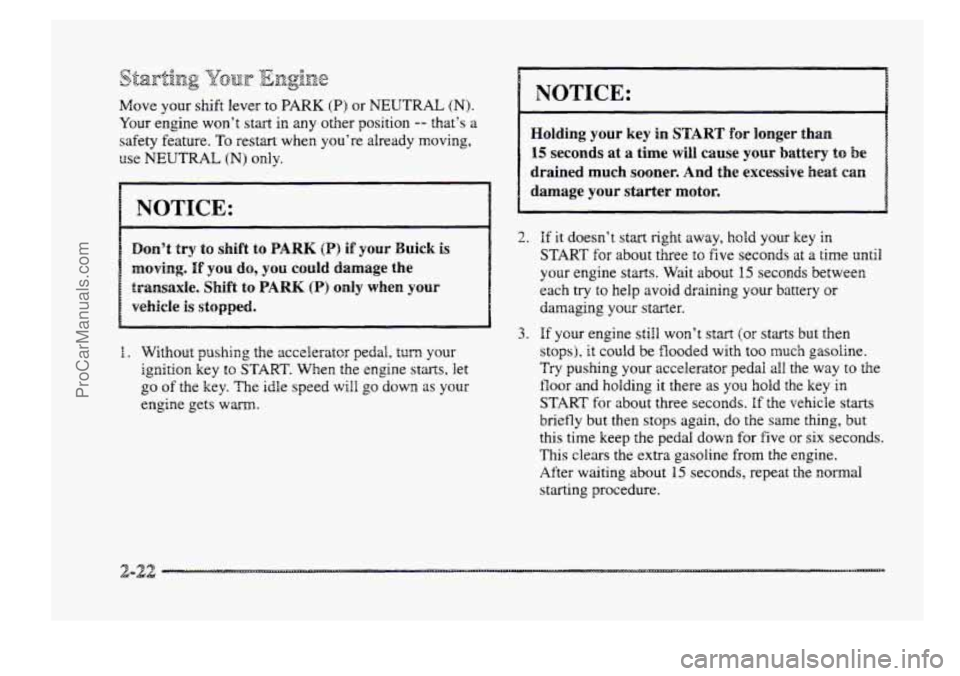
Move your shift lever to BARK (B) or NEUTRAL (N).
Your engine won’t start in any other position -- that’s a
safety feature. To restart when you’re already moving,
use NEUTRAL (N) only.
1 NOTICE:
Don9t try to shift to PARK (a) if your hick is
moving. If YOU do, YOU could damage the
transaxle.
Shift to PARK (P) only when your
vehicfe is stopped.
8. Without pushing the accelerator pedal, turn your
ignition key to START. When the engine starts, let
go
of the key. The idle speed will go down as your
engine gets wann.
NOTICE:
Holding your key in START €or longer than
15 seconds at a time will cause your battery to be
drained much sooner.
And the excessive heat can
damage your starter motor.
2. if it doesn’t start right away, hold your key in
START for about three to five seconds at a time until
your engine starts. Wait about 15 seconds between
each
try to help avoid draining your battery or
damaging your starter.
3. If your engine still won’t start (or starts but then
stops), it could be flooded with too much gasoline.
Try pushing your accelerator pedal
all the way to the
floor
and holding it there as you hold the key in
START for about three seconds. If the vehicle starts
briefly but then stops again, do the same thing, but
this time keep the pedal down for five or
six seconds.
This clears the extra gasoline from the engine.
After waiting
about 15 seconds, repeat the normal
starting procedure.
ProCarManuals.com
Page 91 of 426
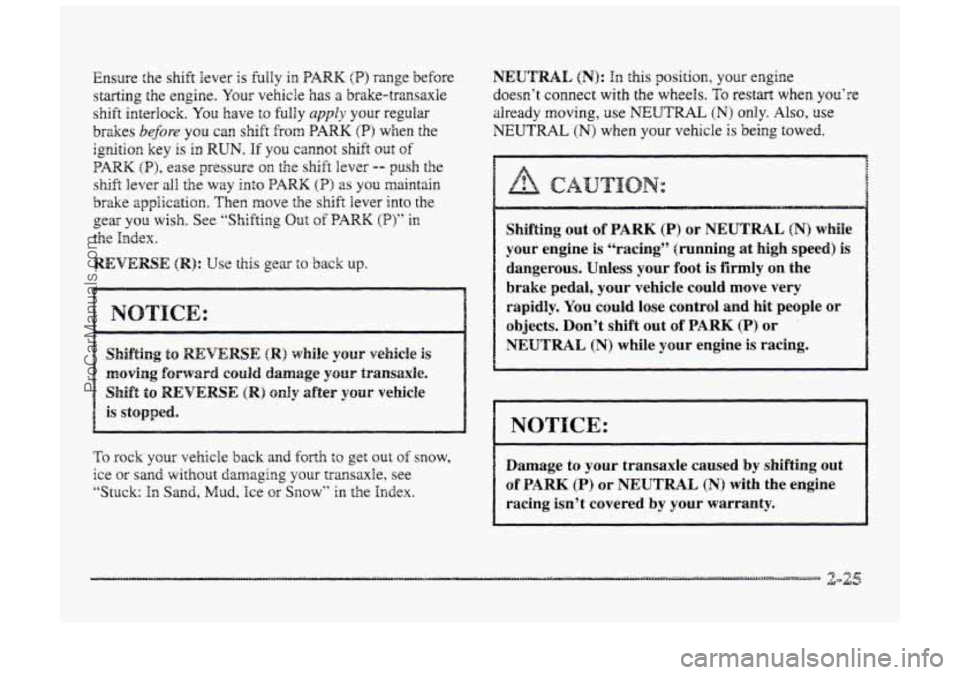
Ensure the shift lever is fuily in PARK (PI range before
starting the engine.
Your vehicle has a brake-transaxle
shift interlock.
You have to fully apply your regular
brzkes
before you can shift from PARK (P) when the
ignition key is in RUN. If you cannot shift out of
PARK (B), ease pressure on the shift lever -- push the
shift lever all the way into PARK (P) as you rnaintain
brake appiic~tion. Then move the shift lever into the
gear you wish. See “Shifting Out of PARK (E’)” in
the Index.
REVERSE (R): Use this gear to back up.
Shift to REVERSE (R) oanhy after vehicle
To rock your vehicle back and forth to get out of snow,
ice sand without damaging your transaxle, see
“Stuck:
In Sand, Mud, Ice or Snow” in the Index.
NEUTRAL (N): In this position, your engim
doesn’t connect with the wheels.
To restart when you’re
already
moving, use NEUTRAL (N) only. Also, use
NEUTRAL (N) when your vehicle is being towed.
Shifting out of PARK (P) or NEUTRAL fN) while
your engine is “racing” (running
at high speed) is
dangerous. Unless your foot is firmly on the
brake pedal, your vehicle could move very
rapidly. You could lose control and hit people
or
objects. Don’t shift out of PARK (P) or
NEUTRAL (N) while your engine is racing.
1 NOTICE:
Damage to your transaxle caused by shifting out
of PARK (P) or NEUTRAL (N) with the engine
racing isn’t covered by your warranty.
ProCarManuals.com
Page 93 of 426
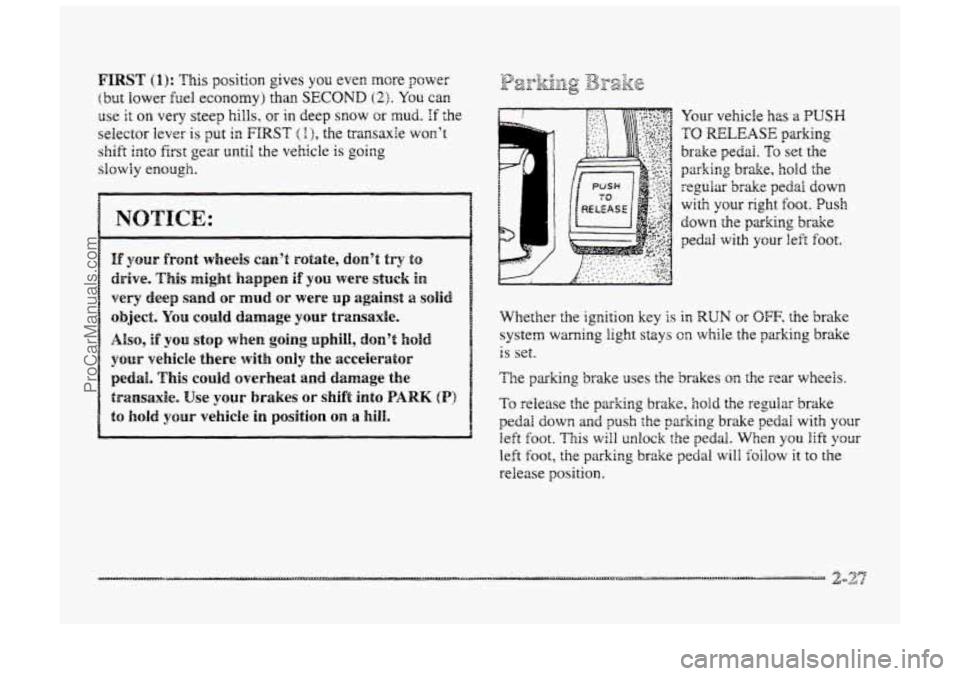
FIRST (I): This position gives you even more power
(but lower fuel economy) than SECOND (2). You can
use it on very steep hills, or in deep snow or mud. If the
selector lever is put in FIRST ( I >, the transaxle won’t
shift into first gear until the vehicle is going
slowHy enough.
If your hplrt wheels can’t rotate, don’t try to
drive. This might happen if YOU were stuck in
very deep sand OF mud or were up against a solid
object. You could damage your transaxle.
Also, if you stop when going uphill, don’t hold
your vehicIe there with only the accelerator
pedal. This could overheat and damage the
transaxle. Use ysur brakes or shift into BARK (P)
Your vehicle has a PUSH
TO RELEASE parking
brake pedai. To set the
parking brake, hold the
regular brake pedal down
with your right foot. Push
down the papking brake
pedal with your left foot.
~~ ~~
Whether the ignition key is in RUN or OFF. the brake
system
wming light stays on while the parking brake
1s set.
The parhng brake uses the brakes the rear wheels.
To release the parking brake, hoki the regular brake
pedal down and push the parking brake pedal with your
left foot. This will unlock the pedal. When you lift your
left foot, the parking brzke pedal will foilow it to the
release position.
ProCarManuals.com
Page 95 of 426
2. Move the shift lever into ?ARK (B) as follows:
8 Pull the iever toward you.
Move the lever up as far as it will go.
3. Move the ignition key to LOCK.
4. Remove the key and take it with you. If YOU can
leave
your vehicie with the ignition key in your
hand, your vehicle is in PARK (P).
ProCarManuals.com
Page 97 of 426
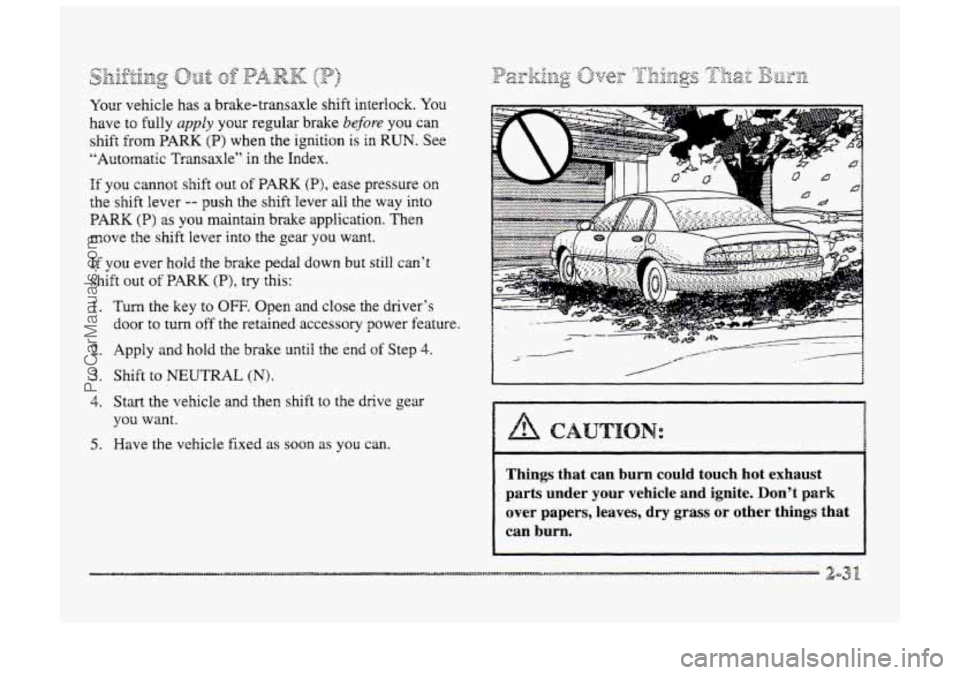
k;zgaA 'T:..:&pa: & LnP :V3;.,,t (.$ dL Bb* pFq- {p :.A AA &L \'& J
Your vehicle has a brake-transaxle shift interlock. You
have to fully apply your regular brake before you can
shift
from PARK (P) when the ignition is in RUN. See
"Automatic Transaxle" in the Index.
If you cannot shift out of PARK (PI, ease pressure on
the shift lever -- push the shift 'lever all the way into
PARK (PI as you maintain brake application. Then
move the shift lever into the gear
YOU want.
If you ever hold the brake pedal down but still can't
shift out of PARK (P), try this:
1.
2.
3.
4.
5.
Turn the key to OW. Open and close the driver's
door to turn
off the retained accessory power feature.
Apply
and hold the brake until the end of Step 4.
Shift to NEUTRAL (N).
Start the vehicle and then shift to the drive gear
you want.
Have the vehicle fixed as soon as you can. CAUTION:
Things that can burn could touch hot exhaust
parts under your vehicle and ignite. Don't park
over papers, leaves,
dry grass or other things that
can burn.
.. . .. 3 32 drn-2
ProCarManuals.com
Page 99 of 426
I& can be dangerous to get ut of your vehicle if
the shift lever is not fully in PARK (PI with the
parking brake firmly set. Your vehicle can roll.
Don’t leave your vehicle when the engine is
running unless you have to. If you’ve left the
engine mnnhg, the vehicle can BP~QV~ suddenly.
You or others could be injured. To be sure YOW
vehicle won’t move, even when you’re OEI fairly
level ground, always set your parking brake and
move the shift lever to PARK (PI.
H701Iow the proper steps to be sure your vehicle won’t
move. See “Shifting Into PARK (P)” in the Index.
If YOU are parking on a hill and if you’re pulling a
trailer, also see “Towing a Trailer” in the Index. Switches
on the driver’s
mest conltrol.each of the
windows while the
ignition is on or retained accessory
power
is active. In addition, each passenger door has a
switch for its own window.
2-33
ProCarManuals.com
Page 105 of 426
......... ... .............
band to a higher sensitivity level.
An initial wipe occurs when you turn the ignition on as a
reminder that the rain sense feature is active.
The moisture-sensing wipers cperate in a deizy mode as
well as a continuous low or high sped, depending on 5ie
mount of moisture on the windshield and the. sensitivity
setting.
Tne IWST and wash cycles operate as nomd and
=e not effected by the moisture-sensing function.
NOTICE:
The moisture-sensing system is activated by turning the
wiper controi band to one of the five sensitivity levels
within the DELAY area. The DELAY position closest ts
OWMIST is the lowest sensitivity setting. This aiIows
more water to coliect on the windshield between wipes.
ProCarManuals.com